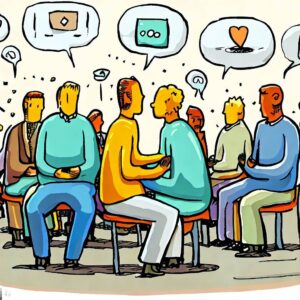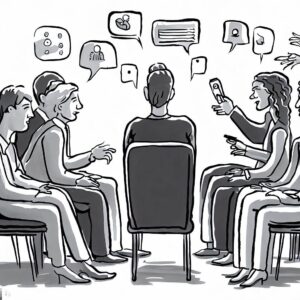As we know without communication, there is no relationship so it is crucial to engage in communication. Whether the relationship is personal or professional, effective communication is the cornerstone of building and strengthening relationships, whether they are personal or professional. One important aspect of effective communication is being fully present and engaged in the conversation. This requires being prepared to put aside our own concerns and biases and to give our full attention to the person we are communicating with. By doing so, we can really get to know them and build stronger relationships based on trust, understanding, and mutual respect.
The Importance of Being Present and Engaged in Communication for Building Strong Relationships

Effective communication is essential in building and strengthening relationships. One important aspect of effective communication is being present and fully engaged in the conversation. This means being here and prepared to be nowhere else. When we genuinely see people, we are better able to help them. However, we often misread people, and this can lead to misunderstandings and damaged relationships.
To avoid misreading people, we need to change the way we speak, ask, and listen. By doing so, we can really get to know them. It’s important to care about the person and the topic, even if it means putting aside our own knowledge or opinions. This requires having an appetite for learning about the other person, their experiences, and their perspectives.
When we give 100% attention to the person we’re communicating with, we communicate that we really care about what they have to say. People enjoy feeling known, and this comes from their talking and our listening. Caring about the person and the topic is more important than our own knowledge or opinions, and this can help to build stronger relationships.
It’s important to be aware that every moment we are either building or weakening each relationship. This means taking responsibility for our own communication and behavior. Sometimes, we may be the problem in a conversation, and it takes real courage to acknowledge this and be there for someone else. It may require us to put aside our own concerns or priorities in order to be fully present and engaged in the conversation.
One technique for being fully present and engaged in a conversation is to use “soft eyes” and “soft ears”. This involves listening intently and looking at the person, but not staring at them too intensely. Feedback is also an important part of effective communication. When we provide feedback on content, we understand the words the person is saying. When we provide feedback on feelings, we understand the person’s emotions. When we provide feedback on intent, we understand what the person intends to do and what is really going on with them.
To provide effective feedback, we need to be listening for feelings and intent, and not thinking about ourselves. This requires putting aside our own biases, assumptions, and concerns, and being fully present in the moment. When we give our full attention to the person we’re communicating with, we demonstrate that we value and care about them. This can help to build stronger relationships based on trust, understanding, and mutual respect.
Being here and prepared to be nowhere else is essential for effective communication and building strong relationships. It requires us to be fully present and engaged in the conversation, to care about the person and the topic, and to put aside our own knowledge, opinions, and concerns. By using techniques such as soft eyes and ears and providing effective feedback, we can better understand the person we’re communicating with and build stronger, more meaningful relationships.
The Power of Asking the Right Questions in Building Strong Relationships

In any relationship, the ability to understand and connect with the emotions and intentions of others is crucial. However, it can be challenging to do so without asking the right questions and creating a safe and welcoming environment for others to express themselves. By facilitating the sharing of emotions and intent, you can ignite motivation and build stronger relationships.
To be fully present and engaged in these conversations, it is important to ask the key questions. Additionally, it can be helpful to probe deeper by asking “What else?” at least three times to encourage the person to share more. As you listen, pay attention to the emotions being expressed and who is doing the most talking.
It is important to approach these conversations with a mindset of learning and understanding, rather than pushing your own point of view. By asking open-ended questions and avoiding leading questions or suggesting your own opinion, you can keep the focus on the other person and expand the conversation rather than limiting it.
Ultimately, asking questions is more effective than providing answers when it comes to building strong relationships and promoting learning. By interrogating reality and promoting open communication, you can deepen your understanding of others and strengthen your relationships.
The Decision Tree Metaphor: A Guide to Delegating Decision-Making Responsibilities and Developing Leadership Skills

The decision-making process is a crucial aspect of leadership. As a leader, it is important to empower your employees by delegating decision-making responsibilities. One way to communicate the level of decision-making authority is through the Decision Tree metaphor. The metaphor helps to identify four levels of decisions based on the potential to impact the tree: leaf level, branch level, trunk level, and root level decisions.
The first level of decision-making is leaf level decisions. These decisions are made by individuals without reporting what they did. They are simple and straightforward decisions that do not require input from others. These decisions are often made on a daily basis and can include actions such as responding to emails, scheduling appointments, or organizing files. Leaf level decisions can be made by anyone and do not require much thought or analysis.
The second level of decision-making is branch level decisions. These decisions are made by individuals who act and then report what they did. These decisions may have more significant impacts on the tree than leaf level decisions. Employees at this level are empowered to make decisions and take action without consulting with others. However, they must report their decisions and actions to their superiors. Examples of branch level decisions may include approving expense reports, hiring new employees, or implementing new procedures.
The third level of decision-making is trunk level decisions. These decisions require individuals to report their decision before taking action. These decisions have a more significant impact on the tree than branch level decisions. Employees at this level must consult with their superiors before making a decision. This allows for a more collaborative decision-making process that ensures everyone is on the same page. Examples of trunk level decisions may include investing in new technology, launching a new product, or rebranding the company.
The fourth and final level of decision-making is root level decisions. These decisions require individuals to consult with others before making a decision. These decisions have the most significant impact on the tree and can determine the overall success or failure of the organization. Root level decisions are made by top-level executives, such as CEOs and board members. Examples of root level decisions may include mergers and acquisitions, major company restructuring, or entering a new market.
It is important to define where the lines are drawn between the levels of decision-making and communicate this to employees. This ensures that employees understand their level of decision-making responsibility and are empowered to make decisions within their level. The Decision Tree metaphor can be used to develop leadership skills and empower employees to take on more responsibility.
However, it is important to note that not everyone is comfortable making decisions on their own. Employees who are not used to making decisions should be taught to identify leaf level decisions that they can make. This allows them to gain confidence in their decision-making abilities and develop their leadership skills. As they become more comfortable making decisions, they can be given more responsibility and move up the levels of the Decision Tree.
The Decision Tree metaphor is a useful tool for delegating decision-making responsibilities and developing leadership skills. It identifies four levels of decisions based on the potential to impact the tree: leaf level, branch level, trunk level, and root level decisions. Defining where the lines are drawn between the levels of decision-making and communicating this to employees empowers them to take on more responsibility and make decisions within their level. With the proper training and guidance, employees can develop their leadership skills and contribute to the overall success of the organization.
Conclusion
In conclusion, being fully present and engaged in communication is essential for building strong relationships. It requires us to put aside our own biases and concerns and to focus on the person we are communicating with. By using techniques such as soft eyes and ears and providing effective feedback, we can better understand the person we are communicating with and build stronger, more meaningful relationships. By creating a safe and welcoming environment for others to express themselves, asking the right questions and delegating decision-making responsibilities, we can deepen our understanding of others and empower them to take on greater responsibilities.
References
- coursera.org: This source provides tips on communication skills, such as being concise and specific, and tailoring your message to your audience.
- positivepsychology.com: This source provides information on the importance of listening in communication, and offers techniques for improving communication in personal and intimate relationships.
